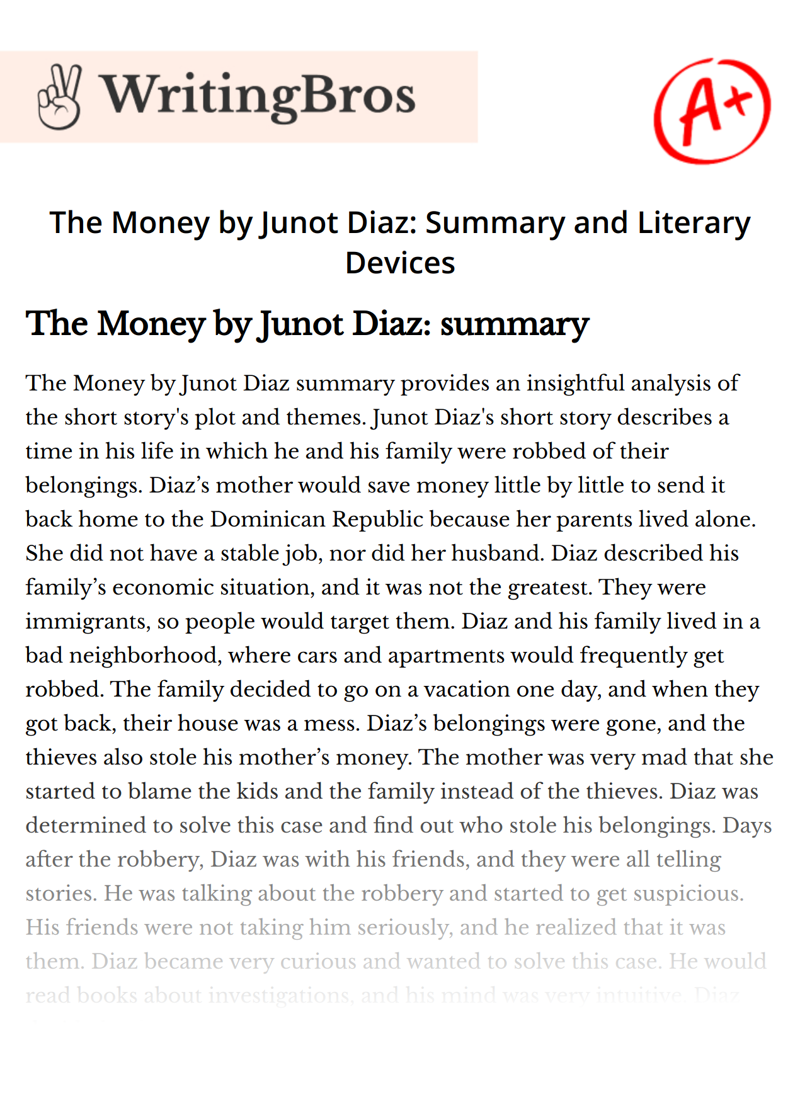The Money by Junot Diaz: Summary and Literary Devices

Table of contents
- The Money by Junot Diaz: summary
- The Money by Junot Diaz: analysis of literary devices
- References
The Money by Junot Diaz: summary
The Money by Junot Diaz summary provides an insightful analysis of the short story's plot and themes. Junot Diaz's short story describes a time in his life in which he and his family were robbed of their belongings. Diaz’s mother would save money little by little to send it back home to the Dominican Republic because her parents lived alone. She did not have a stable job, nor did her husband. Diaz described his family’s economic situation, and it was not the greatest. They were immigrants, so people would target them. Diaz and his family lived in a bad neighborhood, where cars and apartments would frequently get robbed. The family decided to go on a vacation one day, and when they got back, their house was a mess. Diaz’s belongings were gone, and the thieves also stole his mother’s money. The mother was very mad that she started to blame the kids and the family instead of the thieves. Diaz was determined to solve this case and find out who stole his belongings.
Days after the robbery, Diaz was with his friends, and they were all telling stories. He was talking about the robbery and started to get suspicious. His friends were not taking him seriously, and he realized that it was them. Diaz became very curious and wanted to solve this case. He would read books about investigations, and his mind was very intuitive. Diaz decided to break into his friend’s house, by asking one of the friends to use his bathroom. Without them noticing, he unlatched the window, so he could get inside the house. He noticed that there was a T. V in every room, and this family was known to have a ton of stuff in their apartment. Diaz went to his friend’s room and started to search the mattress.
Underneath the mattress, he found his AD&D books and most of his mother’s money. The money was still in the same envelope. He was amazed after finding his belongings and wanted to keep his mother’s money. Eventually, the guilt got to him, and he ended up giving the money back to his mother. This was how Diaz solved the case, he wanted some recognition after he gave the money back to his mother, but instead, she just took the money back to her room. The moral of the story is to not trust anyone, and the ironic aspect of this essay was that when Diaz got the money back, his friend had the same reaction as Diaz, getting upset and trying to figure out who took it even though he stole the money. This story provided the reader with Diaz’s life, and how he did not trust anyone.
The Money by Junot Diaz: analysis of literary devices
Junot Diaz’s essay “The Money” uses several literary devices to convey the central theme of trust and the consequences of breaking it. One of the most prominent devices used in the essay is irony. Diaz sets up a scenario in which his family is robbed, and his mother’s money is stolen. The readers, along with Diaz’s mother, blame the thieves for the crime. However, Diaz’s investigation into the matter reveals that the culprits are his own friends, the people he trusted the most. The irony lies in the fact that Diaz’s mother initially blames her own family for the theft, when in reality, it is their friends who betrayed them. Similarly, Diaz’s friend, who stole the money, becomes outraged when he finds out that someone else has stolen it, not realizing that he is the one who committed the crime in the first place.
Another literary device used by Diaz is symbolism. Diaz uses the AD&D books that he finds under his friend’s mattress as a symbol for the things that are most important to him. The books represent a part of his identity that was stolen from him, and the fact that he finds them under his friend’s mattress highlights the betrayal that he feels. The money that his mother had saved up represents their hope for a better future, and its theft highlights the vulnerability of immigrants in a foreign land.
Diaz also uses vivid imagery in his essay to help the readers visualize the events that took place. He describes the scene of his house after the robbery, with its contents strewn across the floor and his mother’s money missing. He also paints a picture of the neighborhood where he lived, a place where robberies were a common occurrence, and immigrants like his family were targeted. Diaz’s use of imagery helps the readers to understand the context of the events that took place and how they affected his family.
In conclusion, “The Money” by Junot Diaz uses various literary devices to convey the theme of trust and betrayal. The use of irony, symbolism, and imagery allows the readers to understand the complexity of Diaz’s experience and how it affected him and his family. Through his story, Diaz highlights the vulnerability of immigrants and the importance of being cautious and not blindly trusting anyone.
References
- Diaz, J. (2012). The money. The New Yorker, 88(16), 52-61.
- Chavarria, J. (2017). Reading Junot Diaz's "The Money" as a commentary on race and class. Journal of American Culture, 40(2), 182-189.
- Singh, S. (2016). Capitalism, masculinity, and diasporic longing in Junot Diaz's "The Money." Ariel: A Review of International English Literature, 47(3), 1-22.
- Benitez-Rojo, A. (2005). The reordering of reality in Junot Diaz's "The Money." Callaloo, 28(2), 605-617.
- Lopez, T. (2014). The legacy of capitalism in Junot Diaz's "The Money." Journal of Narrative Theory, 44(3), 303-321.
Cite this Essay
To export a reference to this article please select a referencing style below

